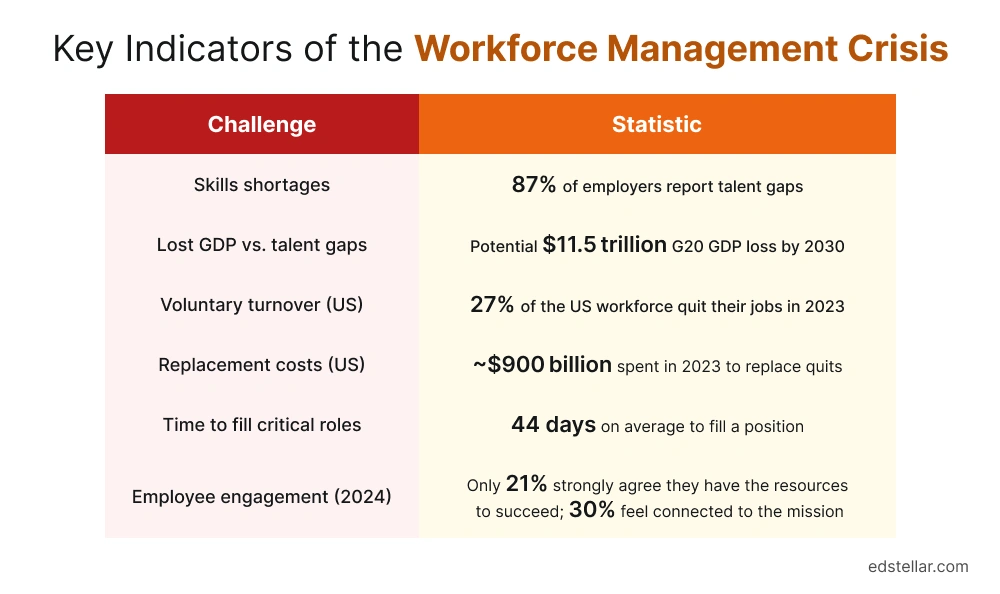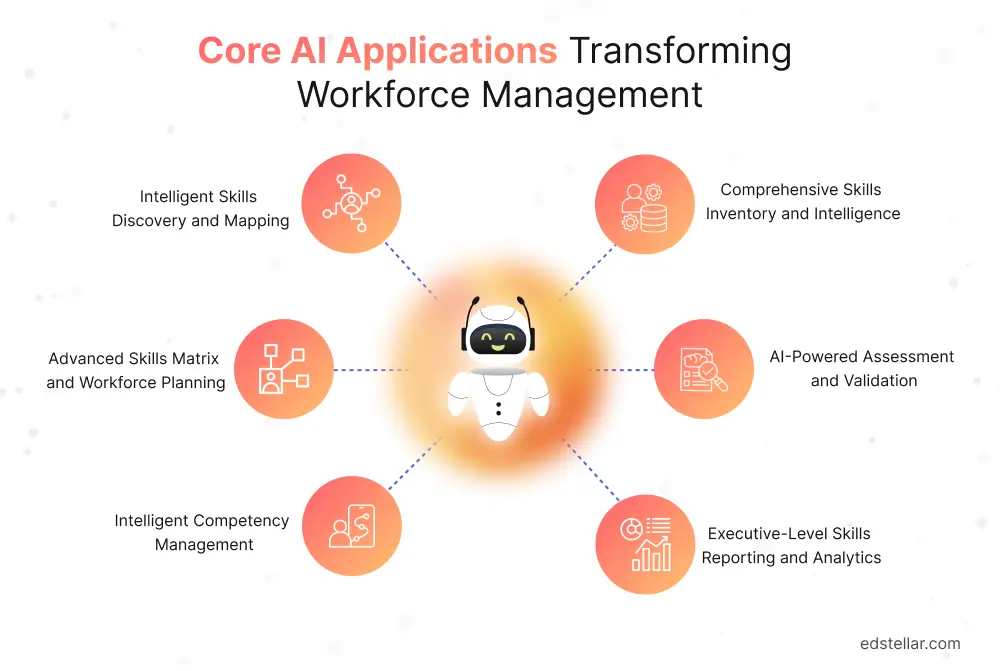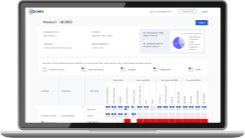
The talent landscape has fundamentally shifted. Companies that master AI-driven workforce intelligence will dominate the next decade, while those clinging to manual HR processes will face mounting costs, skill gaps, and competitive disadvantage.
The global skills shortage has reached crisis proportions. McKinsey's latest research reveals that 87% of companies now face significant talent gaps. This isn't just an HR challenge it's a strategic threat that prevents organizations from executing growth strategies, capitalizing on market opportunities, and maintaining competitive advantage.
Simultaneously, voluntary turnover has created a separate but equally devastating challenge. In 2023, 45 million U.S. workers, representing 27% of the workforce, voluntarily left their jobs. In these cases, the hidden costs extend far beyond recruitment fees: lost institutional knowledge, disrupted team dynamics, delayed project timelines, and diminished customer relationships. With replacement costs ranging from 100-200% of an employee's annual salary, high turnover is directly eroding profitability and shareholder value.
The AI-powered workforce-management imperative is compelling due to the following:
- Unfilled Talent Gaps: A study projects skill shortages could cost the G20 up to $11.5 trillion by 2030, compelling business leaders to adopt AI-driven workforce management to proactively address these gaps, optimize talent deployment, and safeguard organizational competitiveness.
- High Turnover Costs: In 2023, over a quarter of U.S. workers voluntarily quit, forcing employers to spend nearly $900 billion on replacements. Josh Bersin of Deloitte noted that the cost of losing a worker can range from tens of thousands of dollars to 1.5–2x the employee’s annual salary, plus lost productivity.
- Increased ROI: Leading analysts find that AI-driven workforce solutions pay back in months. One benchmark study (by Nucleus) shows an AI scheduling/WFM system returns $12.24 for every $1 invested, mainly from reduced labor costs and turnover, plus 5–60% improvements in efficiency (scheduling time, retention). Even McKinsey notes AI could add $4.4 trillion to global productivity.
- Skills Acceleration: The World Economic Forum estimates half the workforce will need significant upskilling by 2025. Companies that build real-time skills inventories and career-path “champs” outperform peers: LinkedIn data shows organizations with robust career development are far more confident in profitability and talent retention.
- Strategic Mandate: Given these dynamics, leading firms are already shifting from retrospective HR reporting to predictive workforce intelligence. The result: faster hiring, better talent deployment, stronger retention, and a lasting competitive advantage.
The evidence is clear: AI-driven workforce management is no longer a competitive advantage it's a survival requirement. Organizations that act decisively will transform these workforce challenges into strategic assets, while those that delay will face escalating costs and diminishing market position.
This guide provides executives with the strategic framework to navigate this transformation: quantifying ROI to secure investment, addressing implementation challenges to ensure success, and positioning your organization to dominate the AI-driven workforce landscape of the next decade.
Why AI-Driven Workforce Management is No Longer Optional
In today’s talent market, traditional HR methods are falling short. Static spreadsheets and periodic planning can’t keep up with rapid skill shifts or distributed teams. C-suite executives recognize the risks:
- Skills gaps are pervasive. McKinsey finds 87% of companies report a talent shortage, and 64% of L&D leaders now prioritize reskilling. In aggregate, research warns that by 2030, the U.S. alone could lose $8.5–11.5 trillion in GDP to unfilled roles.
- Turnover is explosive. The pandemic era’s “Great Resignation” peaked but didn’t stop. In 2023, nearly 27% of U.S. workers quit. Replacing these departures costs companies almost $900 billion, not counting lost productivity or talent.
- Remote/hybrid challenges. Only 21% of employees feel strongly engaged today, and a record-low 30% feel connected to their company’s mission. Fully remote workers report even more detachment. Engaged, aligned teams are critical to performance, but conventional one-size-fits-all HR can’t easily keep up with hybrid models.
- Competitive pressure. By optimizing workforce intelligence, front-runners gain an edge. For example, laggards incur huge hidden costs (the average turnover cost is 100–200% of an employee’s annual salary.)
These pressures underscore a strategic mandate: workforce management must become data-driven and agile. Just as finance and supply chain embraced analytics decades ago, HR must now leverage AI and advanced analytics. Progressive firms recognize that workforce intelligence is table stakes: 60% of executives say digital/workforce transformation will reshape business by 2030.
In practice, this means adopting tools that deliver real-time visibility into skills, predict staffing needs, and tie talent strategy directly to corporate goals.
Table: Key Indicators of the Workforce Management Crisis

The Economic Case for AI Transformation
As global competition intensifies and talent shortages threaten bottom lines, companies are rapidly embracing AI-powered workforce management to stay ahead. Leading organizations, from tech giants to traditional enterprises, are investing heavily in AI to modernize HR, driven by the realization that outdated, manual processes cannot address today’s dynamic talent landscape.
Convinced by mounting evidence of rapid ROI and strategic gains, executives see AI as the cornerstone of workforce transformation; a path to not just survive but thrive in a skills-driven economy.
The economic case for AI in workforce management is undeniable, delivering transformative value through cost savings, revenue growth, and competitive differentiation. Here’s why forward-thinking leaders are prioritizing this shift:
- Unprecedented ROI Multipliers: Nucleus Research reveals modern AI-driven workforce management systems deliver a staggering $12.24 for every $1 invested. This isn’t just a number it’s a game-changer. By optimizing payroll, streamlining scheduling, and slashing turnover, companies see tangible savings.
For instance, AI-driven systems can cut payroll costs by 5% and reduce turnover by 30–60%, often achieving payback in under six months. These savings free up capital for innovation, growth, and strategic initiatives, making AI a financial no-brainer for CFOs and CEOs alike.
- Catalyzing Productivity and Revenue Growth: McKinsey projects AI could unlock $4.4 trillion in global productivity gains over the next decade, with workforce management at the forefront. Companies that pair AI adoption with aggressive reskilling don’t just keep up; they pull ahead, achieving 36% higher revenue growth than peers, according to recent industry studies.
By leveraging talent analytics and skills development, organizations align their workforce with strategic goals, accelerating time-to-market and boosting customer responsiveness. This is a direct path to revenue growth and market leadership.
- Securing a Competitive Edge: Real-world results prove AI’s impact. Take IBM’s Watson-based attrition model, which predicts 95% of turnover, saving over $300 million by retaining high-value talent.
Such precision empowers leaders to act decisively, protecting critical human capital. Gartner predicts that by 2029, AI-driven HR insights will be a staple in leadership dashboards, with boards demanding real-time workforce data to drive strategic decisions. Companies that act now will outpace competitors, turning talent intelligence into a sustainable advantage.
In essence, AI-powered workforce management is a strategic catalyst, delivering measurable returns within a year. It drives efficiency by reducing hiring and overtime costs, fuels revenue through faster innovation and customer response, and empowers managers to focus on high-impact strategies. For executives, this translates into a clear mandate: embrace AI to unlock unparalleled economic value and secure market leadership in an increasingly competitive world.
How AI Powers Modern Workforce Management
Artificial intelligence and machine learning are not just buzzwords. They fundamentally extend what HR can do:
Traditional HR vs. AI-driven HR: Legacy HR is often static and reactive. Organizations usually rely on historical headcount reports and manual plans. By contrast, an AI-driven approach is continuous and predictive.
For example, traditional workforce analytics generally looks at past data in isolation, whereas workforce intelligence tools provide a real-time, forward-looking view of talent supply and demand.
The table below contrasts current vs. AI-enabled management:
In practice, workforce intelligence harnesses predictive analytics and machine learning to uncover hidden trends, such as turnover risks or emerging skill demands, by analyzing vast HR and market data sets. Advanced systems can “identify patterns and relationships that humans might miss.”
Technology Foundation: At the core, an AI workforce system integrates multiple layers. As one industry framework outlines, a typical stack includes:
- Data Integration: Combining HRIS/ATS data (e.g., skills, roles, performance) with external labor-market information.
- Advanced Analytics: Statistical models and machine learning scan data to uncover trends (e.g., turnover risk, emerging skill needs).
- AI/ML Components: These algorithms can predict attrition, recommend candidates, or map career paths. For example, IBM’s Watson model uses thousands of data points to forecast which employees are likely to leave.
- Visualization & Reporting: Dashboards and BI tools present insights in real time (see table below). Users can query talent data with natural language (as in Databricks’ AI/BI platform), making workforce analytics accessible to managers.
- Continuous Learning: The system continually re-trains on new data. For instance, as roles evolve, the AI updates skill scores and network graphs to stay current.
- Shift from Cost center to Strategic Asset: The key message is that AI makes HR strategic. By accurately measuring and forecasting workforce capacity, HR stops firefighting and starts shaping the business.
For example, instead of simply tracking open requisitions, AI systems can predict which roles will be most critical in six months. Insights on talent supply (skills at risk of obsolescence) then feed into strategic planning. As the LinkedIn Learning Report emphasizes, organizations that treat career development (enabled by these capabilities) as a business enabler see outsized business results.
Core AI Applications Transforming Workforce Management
Modern workforce platforms offer a suite of AI-powered features. We focus on six core capabilities. Each combines industry best practices with practical use cases:

Intelligent Skills Discovery and Mapping
AI helps employees with identifying their skill sets, and provides suggestions when mapping skills to job roles. Instead of relying on static resumes or manager judgments, the platform analyzes performance reviews, training records, and external profiles to support in the process of building a comprehensive skills database for the organization. This delivers real-time talent visibility to executives and significantly enhances the accuracy and quality of HR data.
Key benefits include:
- Talent discovery & visibility: By linking related skills, the system uncovers hidden talent pools. For instance, it might reveal that a data-scientist team member has advanced UX design skills. This reduces internal hires’ time to find fit candidates.
- Data-driven planning: Leaders can see which critical skills are lacking. A machine-learning model might flag, say, an upcoming demand for “AI ethics” expertise, allowing preemptive training or hiring.
- Use case: When AT&T mapped skills and launched an ambitious reskilling program for its 280,000 employees, half of its technical roles were filled internally, and promotions accelerated (47% of promotions went to upskilled employees). This example illustrates how systematic mapping + training can cut external recruiting by identifying the right people for the right future roles.
In summary, the skills mapping feature turns ambiguous skills data into clear insights, enabling strategic workforce planning and ROI through reduced search times and greater internal hire rates.
Comprehensive Skills Inventory and Intelligence
A central skills inventory, updated continuously, is a strategic asset. It captures each individual’s verified competencies (technical, managerial, etc.) and enables HR and managers with the comparison of skills against business needs.
Think of it as a living database where every person is tagged with proficiencies and endorsements.
- Strategic Planning: Executives gain a “talent intelligence” interface. For example, a CFO can query how many employees have expertise in “data science” vs. the projected need next year. This shifts planning from guesswork to evidence-based strategy.
- Competitive Edge: LinkedIn reports that 49% of learning leaders see a skills crisis, and the solution is blending learning with career mapping. A robust skills inventory is the foundation for that blend.
- Benchmark: The World Economic Forum estimates that more than half of workers need reskilling by 2025. A skills inventory allows precise reskilling programs. Instead of blanket training, AI pinpoints the most critical skills gaps and suggests personalized learning paths.
Table: Skills Inventory Use Cases
During a sudden business shift, leadership instantly knows if there are qualified people in-house and where to upskill.
Advanced Skills Matrix and Workforce Planning
The skills matrix is a powerful tool enabling teams and managers to assess the skill levels of a select group of employees against benchmark scores, while a competency matrix evaluates broader capabilities like leadership or problem-solving. By aggregating and visualizing this data across roles, levels, and departments, the matrices create a heatmap revealing where critical skills and competencies are abundant or scarce.
This provides executives with a clear, actionable map for future workforce architecture, succession planning, and understanding team capabilities.
- Succession and Gaps: Using the matrix, leaders spot who could step into each key role and where skill bottlenecks exist. For example, if half of the senior engineers lack “cybersecurity” skills, the matrix will highlight this risk. A dynamic skills matrix closes that gap by turning candidacy data into a live plan.
- Organizational Agility: By layering business forecasts, the matrix can simulate scenarios. If the company plans to enter a new market, the model shows which existing teams have relevant experience. This cuts planning time dramatically and means leadership makes informed tradeoffs.
- Typical ROI: Formal workforce planning, including the use of skill matrices, significantly reduces time-to-fill for critical roles and improves project staffing speed. Engaging line managers with an interactive matrix often enhances their ability to identify internal talent.
Table: Skills Matrix Snapshot Visualization
The table shows a simplified heatmap of skill coverage. (High/Low indicates team strength in that skill.)
How It Works: Each cell reflects the aggregated proficiency score of employees in that department for the specified skill, based on AI-evaluated data (e.g., test results, project outcomes). For example, Department A’s “High” rating in Cloud/DevOps indicates strong expertise, while Department B’s “Low” rating flags a need for upskilling. The heatmap uses color gradients (e.g., green for High, yellow for Medium, red for Low) to make gaps and strengths instantly recognizable, enabling executives to prioritize training or hiring.
AI-Powered Assessment and Validation
Traditional assessments, such as manual interviews and generic tests, are labor-intensive and prone to bias. AI revolutionizes this by helping speed up the creation of questionnaires, tailoring questions to specific roles using data-driven insights, and scaling the assessment process to evaluate large candidate pools efficiently.
Additionally, AI objectively corrects responses and delivers instant, accurate results, reducing human error and bias. This ensures consistent, fair evaluations, improving hiring accuracy and boosting workforce diversity. AI brings objectivity and scale to evaluating skills:
- Consistent Metrics: Machine-driven tests ensure everyone is measured against the same criteria. For example, a data science assessment might be scored by an algorithm analyzing code quality and efficiency. This reduces human bias. AI-based assessments can improve hiring accuracy by 25–40% and boost workforce diversity (with one report citing a 35% increase).
- Continuous Validation: Beyond hiring, AI assessments can track skill mastery over time. The platform might regularly quiz employees on core competencies, updating their profiles. This provides executives with up-to-date confidence levels in the talent pool. If someone’s score on a critical skill drops, the system flags it for retraining.
- Efficiency and Trust: AI assessments cut time to competency. By demonstrating objective criteria, executives gain trust in talent decisions. This is vital for “board readiness.” If leadership can see that promotions or hires are backed by data, it streamlines approvals.
By adopting AI assessments, companies gain executive confidence in talent quality. Over time, this leads to better placement, lower mis-hire rates, and solid evidence for promotions and succession.
Intelligent Competency Management
Competency management aligns employee skills, behaviors, and capabilities with organizational goals, creating clear career pathways and development plans. It’s essential for boosting learning, performance and retention, as employees seek transparent growth opportunities. AI-enabled tools enhance this by analyzing performance data, skills inventories, and business needs to recommend personalized career milestones and training programs.
These tools suggest mapping of competencies, such as leadership or problem-solving, to future roles, ensuring targeted development. By leveraging AI for competency management, organizations transform it into a strategic asset, aligning talent with business objectives and fostering a motivated, future-ready workforce. This proactive approach empowers organizations to retain top talent and drive long-term success. It ties individual competencies to career milestones:
- Personalized Career Maps: Using the skills inventory and organization hierarchy, the platform suggests potential future roles and the skills needed for each. For example, it might show an engineer that acquiring “data leadership” skills could prepare them for a director role. This engages high performers by clarifying their path.
- Learning ROI Optimization: Competency management links L&D programs to business outcomes. AI can prioritize training that fills the biggest competency gaps. Companies that empower learning tied to career goals are significantly more successful: “career development champions” are 42% more likely to lead in emerging tech adoption and are more optimistic about profit and retention.
- Retention Multiplier: Having a clear career ladder is motivating. Formal career planning boosts engagement, and younger employees are especially sensitive: 90% of 18–34-year-olds said a succession plan improves engagement. Competency management is the engine behind such plans.
Table: Career Pathing Example
The table shows sample AI-driven suggestions for career progression.
Executive-Level Skills Reporting and Analytics
Finally, AI workforce management tools provide C-suite dashboards that translate all this data into strategic intelligence. AI-powered C-suite dashboards deliver strategic workforce intelligence. AI crafts concise report summaries from skills and performance data, visualizes trends via heatmaps and graphs, and offers natural language queries and predictive modeling.
These tools provide board-ready insights into workforce health, skill gaps, revenue impact, and DEI progress, enabling data-driven decisions aligned with business goals. These reports show the health and trajectory of the workforce in business terms:
- Board-Ready Insights: Executive summary reports can highlight skill gaps impacting revenue, compare labor costs across planning scenarios, or track progress toward DEI goals. According to Gartner, by 2029, 10% of corporate boards will use AI to challenge executive decisions. To stay relevant, HR must speak the language of the boardroom. Workforce analytics can be integrated into enterprise BI tools, surfacing metrics like time-to-fill versus revenue growth or skills readiness for high-impact projects.
- Real-Time KPI Tracking: Dashboards update dynamically as workforce data evolves. Key performance indicators include vacancy rates, time-to-productivity, internal fill rates for strategic roles, and training effectiveness measured by skill score improvements. Executives can set targets and receive alerts, enabling talent strategies to be managed as actively as sales or operations.
- Strategic Scenario Modeling: AI can simulate the financial impact of changes like a 5% increase in turnover within a critical team. This shifts talent-related risks from speculation to measurable planning.
Skills reporting makes talent data actionable, positioning HR as a driver of business strategy and performance.
The Business Case: AI-Powered Workforce Transformation
Investing in AI-powered workforce management is no longer a question of “if,” but “how fast.” For executive leadership, the conversation revolves around outcomes: What’s the return? How does this accelerate business performance? The answer lies in measurable value across revenue growth, cost optimization, efficiency gains, and risk reduction.
Quantifiable Business Impact
When the right talent is identified, developed, and deployed with precision, organizations reduce delays in product development, customer service, and strategic execution. For example, McKinsey reports AI-driven workforce tools can contribute $4.4 trillion in productivity gains globally.
From a cost-saving perspective, automation of routine HR functions, resume screening, scheduling, and onboarding reduces administrative load and recruitment expenses. AI enables internal talent discovery, decreasing the need for agency fees and job board advertising. More importantly, the impact on retention is substantial.
Efficiency is where the operational gains accelerate. AI improves time-to-hire, onboarding ramp-up time, and skills development throughput.
Risk Mitigation and Future-Proofing
Beyond operational efficiencies, AI strengthens organizational resilience by enabling early detection of workforce risks, skills shortages, compliance gaps, burnout patterns, and attrition hotspots. Through predictive modeling and talent forecasting, HR leaders can plan proactively rather than reactively. PwC’s 2025 AI Jobs Barometer notes that industries with high AI adoption see wages rise twice as fast, supporting retention in automatable roles.
This foresight is especially crucial as businesses face ongoing economic uncertainty, evolving regulations, and rapid technological change. AI equips enterprises to pivot faster through internal upskilling and cross-functional talent redeployment, lowering dependency on external hiring and reducing time lost to transitions.
Competitive Advantage Creation
Organizations embracing AI workforce management create a multi-tiered competitive edge:
- Operational Efficiency: Automating manual tasks allows HR teams to focus on strategic goals.
- Strategic Agility: Real-time data helps adjust workforce strategies in response to market shifts.
- Innovation Enablement: High-visibility skills data aligns talent strategies with innovation roadmaps. AI tools accelerate client advisory speed amid market volatility, with JPMorgan’s AI projected to boost its client roster by 50% in three to five years, while contributing to a 20% gross sales increase from 2023 to 2024.
Table: Summary of ROI Impact by Dimension
Implementation Strategy for Executive Leadership
Rolling out an AI-enabled workforce system requires more than just a technology plan. It requires a leadership-led change transformation. Success depends on setting a strong foundation that includes strategic sponsorship, organizational readiness, a clear data strategy, and phased execution.
Building the Foundation for Success
The cornerstone is executive sponsorship. Workforce AI must be positioned as a C-level strategic priority, tied directly to business KPIs to boost revenue acceleration, cost optimization, and innovation cycles. Gaining board-level commitment and integrating AI into business scorecards generates momentum and unlocks funding. Leaders must publicly endorse AI initiatives as part of the organization's competitive strategy, not merely an HR experiment.
Next comes change management, which addresses the human element. Humans matter. Training and communication are critical. Organizations often underestimate this: 63% cite human barriers (resistance, fear) as the top AI challenge. Resistance is common, particularly where AI intersects with employee roles. A people-first approach works best: engage stakeholders early, clarify how AI augments their decisions, not replaces them, and roll out user training alongside the technology.
Executives must prioritize change management and capability building early. Corporate training programs like Edstellar’s “AI for Managers” and “AI for Project Managers” are essential for equipping leaders with the strategic and technical literacy required to oversee AI-driven workforce transformation. These programs empower mid-level managers and project leads to interpret AI recommendations, align team resources, and drive adoption at scale.
Data readiness is another essential pillar. AI workforce tools require clean, unified, and accessible data across talent acquisition, performance, learning, and engagement systems. This may involve consolidating fragmented systems, investing in a workforce data warehouse, and integrating with enterprise BI tools to ensure executive usability.
Phased Implementation Approach
Implementing an AI workforce management tool demands a structured, phased approach to manage the significant organizational effort required for successful adoption. Each phase involves specific steps, securing leadership commitment, engaging stakeholders, integrating data systems, training teams, and communicating benefits to drive change management and ensure AI tools like skills mapping and predictive analytics deliver strategic value.
These steps address resistance, align with business goals, and transform HR into a proactive, data-driven function.Table: AI Workforce Implementation Roadmap
Implementation Steps:
- Assess Readiness: Evaluate HR systems and workforce needs to identify gaps.
- Secure Leadership Buy-In: Align AI with business KPIs via C-level sponsorship.
- Engage Stakeholders: Involve teams to address resistance and clarify AI’s role.
- Integrate Data: Unify HRIS, ATS, and external data for seamless analytics.
- Train Teams: Use programs like Edstellar’s AI for Managers to build fluency.
- Communicate Benefits: Promote AI’s value to sustain adoption and engagement.
These steps ensure AI-driven workforce transformation aligns with strategic goals, requiring dedicated effort to overcome barriers and maximize impact.
Measuring Success and Continuous Optimization
Success hinges on tracking and adjusting based on data. Leading organizations implement a real-time dashboard with three categories of KPIs:
- Talent KPIs: Time-to-fill, attrition rate, internal hire percentage, training completion.
- Efficiency KPIs: Cost per hire, HR hours saved, skills acquired per dollar spent.
- Business Impact KPIs: Revenue per employee, team productivity, project delivery speed.
Executives should review these KPIs quarterly, identifying trends, adjusting models, and adding data layers as needed.
Future Outlook: The Next Decade of AI-Driven Workforce Management
Over the next decade, AI will redefine how organizations manage talent. The shift will not be incremental it will be exponential. Leaders who act now will gain a sustainable edge.
- Generative AI and Personalization: This year, there’s widespread use of AI chatbots for HR inquiries and personalized career guidance. Advanced systems will deliver learning modules tailored to each employee's skill profile in real-time, integrating with enterprise BI to support daily decisions. Large language models (LLMs) will coach, train, and recommend developmental paths with unprecedented precision.
- Gartner's Prediction: By 2029, 10% of corporate boards will consult AI to challenge executive decisions. Talent data will become as central to boardroom discussions as financials. CHROs should invest now in augmented analytics, AI-generated insights embedded in dashboards, and ensure data is clean, integrated, and ready for strategic analysis.
- Workforce Reskilling at Scale: Tools like AI tutors, immersive VR simulations, and adaptive learning engines will accelerate capability building. Executives must plan for continual reinvestment in skills. The future of work is “hyper-human,” where AI handles routine tasks so people can evolve into more creative and strategic roles.
- Ethics and Trust: As AI influences hiring, promotion, and performance reviews, ethical governance becomes essential. Companies must implement transparent algorithms, explainable AI, and bias audits. Regulations are coming, and those who establish ethical review boards and audit trails now will stay ahead.
Strategic Recommendations:
- Invest early in AI infrastructure and workforce intelligence.
- Partner boldly with AI-competent corporate training providers like Edstellar.
- Lead visibly executive endorsement drives adoption.
- Cultivate a continuous learning culture that rewards growth.
Organizations that act now will secure a lasting lead. As SHRM’s vision suggests, tomorrow’s top companies will “harness AI to empower employees and unlock creativity” while keeping human well-being at the center.
Conclusion
The message is clear: Act now or fall behind. Talent disruption is accelerating, and organizations that cling to outdated workforce management approaches will find themselves at a competitive disadvantage. AI-powered workforce intelligence isn’t just a technological shift; it’s a leadership imperative.
By embracing advanced capabilities like skills mapping, predictive analytics, competency intelligence, and continuous learning ecosystems, executives can transform workforce operations from a reactive function into a predictive, strategic powerhouse.
Next Steps for Leadership
- Start with a pilot initiative: Choose a high-impact area such as critical roles, upcoming initiatives, or transformation projects.
- Assemble a cross-functional steering team: Include HR, L&D, tech, and business leaders.
- Define success metrics: Focus on outcomes like time-to-productivity, internal mobility, and retention.
- Leverage real-time skills data: Begin embedding intelligence into everyday decisions.
To support AI-driven workforce transformation, address skill gaps in leadership and project management through targeted L&D solutions. Edstellar, a premier Learning & Development partner, offers L&D consulting, training needs analysis, and corporate instructor-led training, including programs like Corporate AI for Managers and AI for Project Managers. These equip executives and teams with the technical fluency and strategic frameworks to lead in the AI era.
With over 2,000 tailored instructor-led programs across technical, behavioral, leadership, and compliance disciplines, Edstellar drives enterprise-wide skilling at scale. Its Skills Intelligence tool, featuring the Skill Matrix, enables organizations to map, manage, and optimize workforce capabilities with real-time insights, ensuring alignment with strategic goals.
Whether you’re planning a skills transformation or scaling workforce AI adoption, Edstellar delivers both the training and the intelligence layer to make it successful.
The opportunity is now. Secure your competitive edge. Build the workforce of tomorrow, today.
Explore High-impact instructor-led training for your teams.
#On-site #Virtual #GroupTraining #Customized

Bridge the Gap Between Learning & Performance
Turn Your Training Programs Into Revenue Drivers.
Schedule a ConsultationEdstellar Training Catalog
Explore 2000+ industry ready instructor-led training programs.

Coaching that Unlocks Potential
Create dynamic leaders and cohesive teams. Learn more now!


Want to evaluate your team’s skill gaps?
Do a quick Skill gap analysis with Edstellar’s Free Skill Matrix tool

Transform Your L&D Strategy Today
Unlock premium resources, tools, and frameworks designed for HR and learning professionals. Our L&D Hub gives you everything needed to elevate your organization's training approach.
Access L&D Hub Resources.svg)
.svg)



.svg)

.svg)
.svg)
.svg)
.svg)

